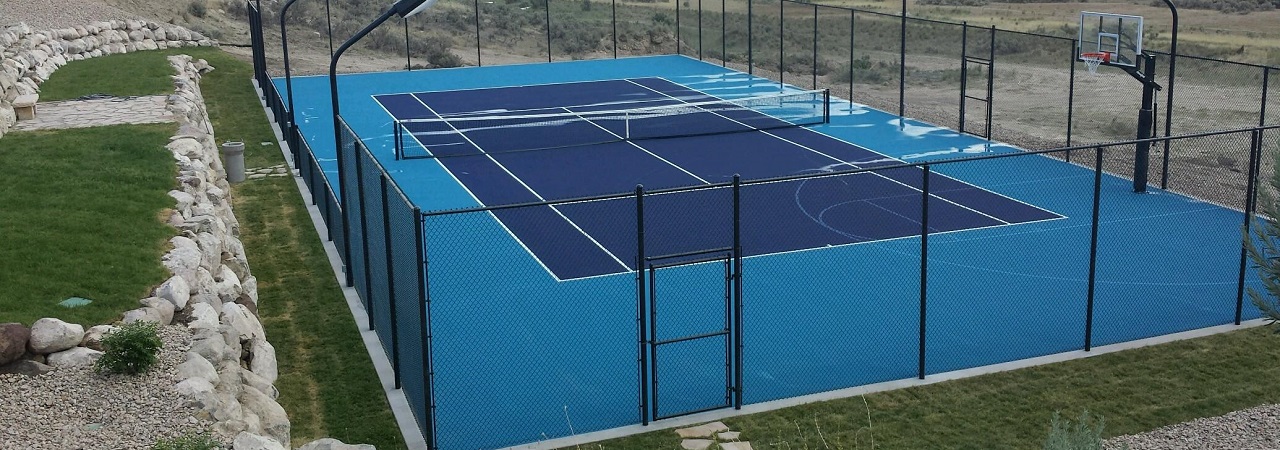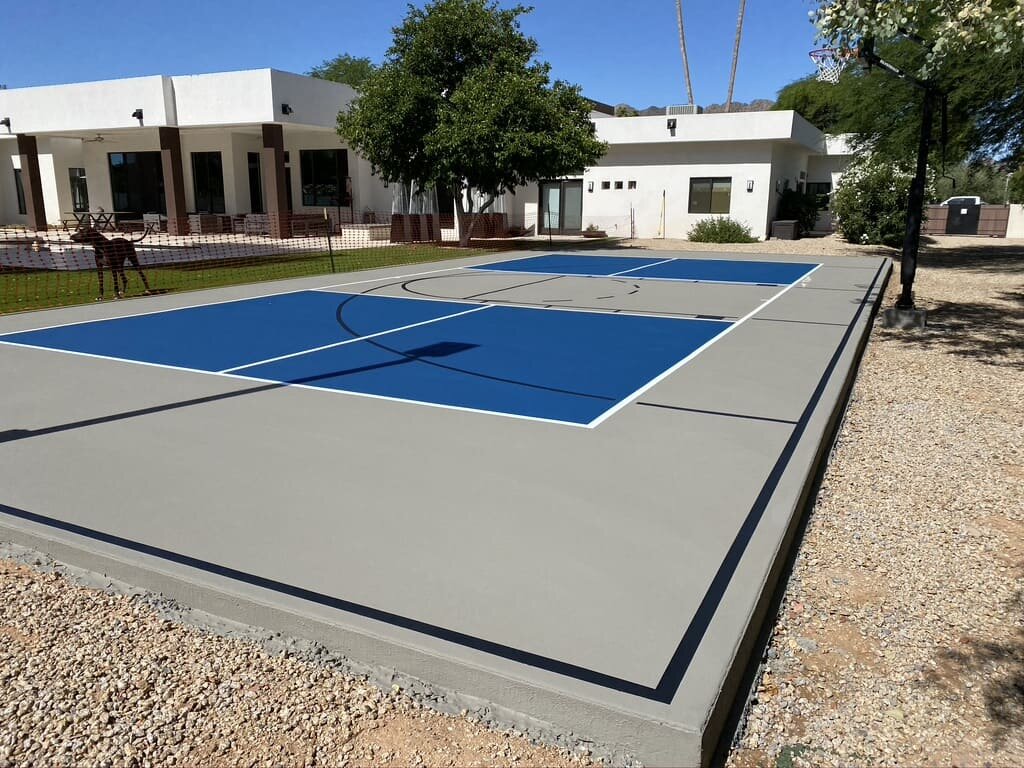What to Anticipate from a Professional Pickleball Court Contractor Throughout Installation
What to Anticipate from a Professional Pickleball Court Contractor Throughout Installation
Blog Article
A Comprehensive Guide to Creating the Perfect Pickleball Court for All Skill Levels
Designing a pickleball court that provides to players of differing skill levels necessitates a complex method, encompassing essential components such as court dimensions, surface area products, and accessibility features. What particular considerations must be focused on to ensure a successful application?

Recognizing Court Dimensions
Recognizing the measurements of a pickleball court is critical for both designers and players, as these specifications make sure a reasonable and constant playing experience. A basic pickleball court gauges 20 feet large by 44 feet long for both singles and increases play. The court is divided into two equivalent halves by a net that stands 36 inches high at the sidelines and 34 inches at the facility.
Trick functions of the court consist of the non-volley zone, commonly referred to as the "kitchen," which extends 7 feet from the web on both sides. This location is critical for regulating gamer motion and volleying, making certain strategic play. Additionally, the solution locations on each side of the court are vital, measuring 10 feet vast and 15 feet deep, developed to fit correct serving strategies.
Bordering the court, a location of at least 10 feet need to be assigned as the security area, allowing players enough space to relocate and protect against injuries throughout play. Adhering to these dimensions not just fosters fair competitors however also promotes safety and security and enjoyment for all participants, making it vital for any type of pickleball court design.
Choosing the Right Surface Area
The option of playing surface for a pickleball court significantly affects the game's dynamics and player experience. Picking the suitable product is critical for ensuring player security, efficiency, and convenience. Typical surface areas include asphalt, concrete, and specialized sporting activities flooring.
Asphalt is a preferred option because of its price and longevity. It offers a consistent playing surface area but can be difficult on joints over prolonged play. Concrete, while comparable in resilience, provides marginal flexibility, potentially causing raised impact on players' bodies.
For an extra supported experience, many facilities go with specialized sporting activities floor covering, such as artificial surfaces or modular floor tiles. These products typically include shock-absorbing homes, decreasing the risk of injuries and enhancing gamer convenience. Such surfaces can enhance sphere bounce consistency, which is essential for reasonable play.
When picking a surface, consider aspects such as climate, maintenance requirements, and the intensity of play. A well-chosen surface area not only improves gameplay yet likewise adds to the durability of the court itself. Ultimately, comprehending the subtleties of various materials will aid in developing an ideal pickleball environment customized to numerous skill levels.
Ideal Court Layout
An optimal court format is necessary for maximizing both gamer performance and spectator pleasure in pickleball. The measurements of a common pickleball court are 20 feet large by 44 feet long for doubles play, keeping a clear limit that enhances gameplay. The web, placed at 36 inches high at the sidelines and 34 inches in the facility, is important for maintaining the dynamics of the game.
Incorporating marked areas around the court for players to relocate openly is essential. A minimum of 10 feet of clearance on all sides of the court is suggested to protect against accidents and give space for viewers. site web Additionally, alignment plays a substantial function; the court ought to preferably be straightened north-south to decrease the effect of sun glow on gamers during optimal hours.
Effective spectator placement is just as essential. Raised seeing areas or bleachers placed behind the sidelines can improve the experience while making sure security. Finally, noticeable and clear court markings aid in gameplay, with contrasting colors for boundaries and non-volley areas that delineate crucial locations for players. On the whole, a well-designed court layout fosters an engaging environment for both viewers and gamers.

Availability Factors To Consider
When making a pickleball court, making certain ease of access for all players, including those with specials needs, is critical. A thoughtfully made court can promote inclusivity and motivate involvement from individuals of differing abilities.

Gain access to paths to the court need to also be carefully intended. Guarantee that paths resulting in the court are broad enough for wheelchair customers and are geared up with ramps where required. Signage should be clear and large sufficient to be quickly read.
Furthermore, seating locations ought to be designed to allow for very easy access to and from the court. This includes giving assigned rooms for spectators who might have mobility obstacles.
Finally, guarantee that you could check here restroom centers nearby fulfill availability standards. By taking into consideration these elements, you can produce a pickleball court that is inviting and usable for every person, thus advertising a varied and vibrant neighborhood of gamers.
Upkeep and Maintenance
Appropriate upkeep and maintenance of a pickleball court are necessary for ensuring optimal playing conditions and lengthening the life-span of the center. Regular evaluations need to be performed to identify and deal with any type of problems or use, such as splits in the surface area or loosened netting. These problems, if left neglected, can adversely affect gameplay and security.
Surface upkeep is vital; courts need to be cleaned up often to get rid of particles, leaves, or dust that can influence grip. For hard courts, periodic pressure washing is recommended to preserve surface integrity and visual appeals. If your court is made of softer materials, such as asphalt, resurfacing or sealing may be necessary to protect versus weather-related wear.
Furthermore, net elevation and tension need to be examined on a regular basis, as incorrect settings can modify gameplay. Preserving bordering areas, including secure fencing and lighting, is just as crucial for making sure a enjoyable and secure atmosphere.
Verdict
Finally, the design of an ideal pickleball court requires a precise approach that includes correct dimensions, appropriate surface area products, and thoughtful design. Pickleball court contractor. Making certain ease of access for all spectators and players is important go to this website for cultivating an inclusive atmosphere. Moreover, normal upkeep is critical for sustaining court high quality and security. By sticking to these standards, the excellent pickleball court can be developed, advertising pleasure and athletic development for players of differing skill degrees.
Creating a pickleball court that provides to players of differing skill degrees requires a multifaceted technique, encompassing important components such as court dimensions, surface area materials, and access attributes.Comprehending the measurements of a pickleball court is vital for both players and developers, as these requirements make certain a fair and regular playing experience.The option of playing surface area for a pickleball court considerably affects the video game's dynamics and player experience.An optimum court design is vital for optimizing both gamer efficiency and spectator pleasure in pickleball. By sticking to these guidelines, the ideal pickleball court can be developed, advertising enjoyment and athletic development for gamers of differing ability degrees.
Report this page